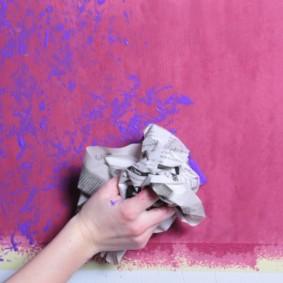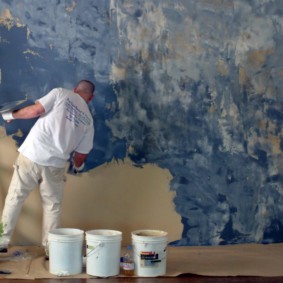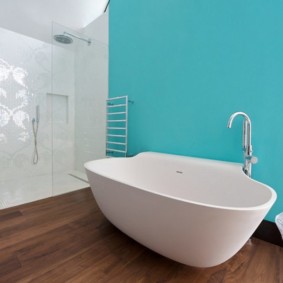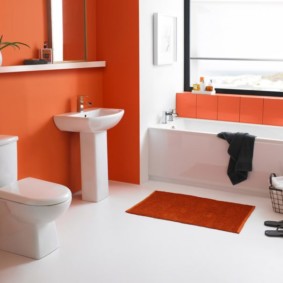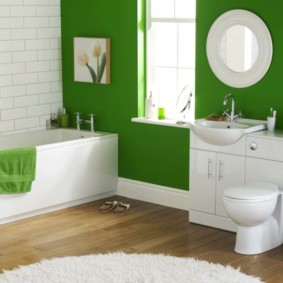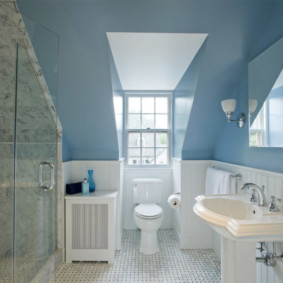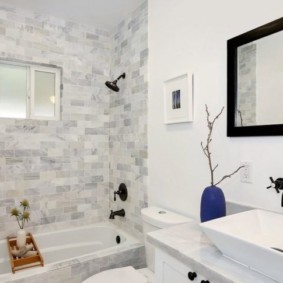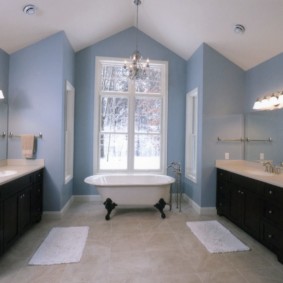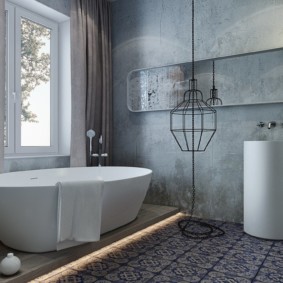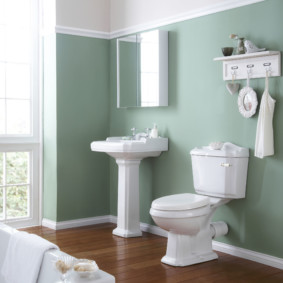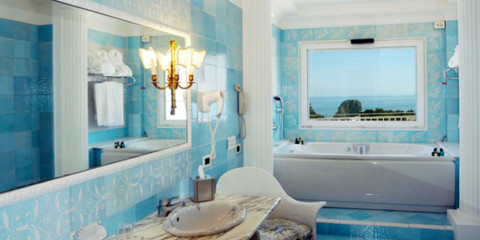 A bathroom
2 m2 bathroom design in different types of housing
A bathroom
2 m2 bathroom design in different types of housing
The walls in the bathroom can be tiled, mosaic, washable wallpaper, plastic panels, or paint. Painting the walls in the bathroom is becoming more widespread and popular due to the fact that this option is cheap and provides wide scope for the use of design, selection of colors, texture of the material, drawing a picture or ornamental pattern.

Painted walls are one of the most economical bathroom finishes available.
Why it is worth painting the walls in the bathroom
Content
- Why it is worth painting the walls in the bathroom
- Pros and cons of painted walls
- Decorative methods of painting
- What colors are suitable for finishing a bathroom
- Choice of color and gloss
- Paints that are not recommended for painting in the bathroom
- Video: real bathroom with painted walls
- Photo ideas for painting walls in the bathroom
The most convenient method of proving the benefits of painting walls in the bathroom is the refutation of some persistent stereotypes and misconceptions that have developed regarding this finishing treatment of the interior surfaces of rooms.
- The stereotype is the first: "Appearance, after processing, using coloring materials, is not presentable enough, gray and dull." A similar opinion developed back in Soviet times, when, for reasons of saving state funds, the inner walls of hospitals, clinics, kindergartens, schools were painted in faded, ugly colors, using the most budgetary dye. This historical fact has created a persistent associative series between this type of processing with dullness, uniformity and musty. The stereotype breaks down after viewing examples of successful work done using modern design approaches and materials. The situation has changed dramatically - now the paint is used to decorate the bathroom in a wide range of decorative styles and combines perfectly with both the elaborate rococo openwork and the bright contrast of modernity.

In fact, paint is just the material with which you can create an original and unique bathroom design
- The second stereotype is: “Painted walls are harmful to the body.” With the right selection of paint, this statement loses its former relevance. High-quality aqueous emulsion dyes are created from non-toxic materials.

Paint can be good and not very good, as well as tile, wallpaper or plastic
- The stereotype is the third: “Walls are covered with cracks, mold and fungus start on them.” It also depends on the quality of the paint. If fungicidal and algicidal compounds are present in its composition - the fungus is completely not afraid of it.

Cracks occur primarily with poor-quality plaster or structural defects in the walls.
Pros and cons of painted walls
Finishing a bathroom by painting has its own particular advantages and disadvantages.
Benefits:
- The material is cheap and affordable. When processing a bathroom with a tile and painting - the last way will be cheaper and more convenient.
- Simplicity and ease of use, ease of care. The coating is quite homogeneous, it is easy to care for it, periodically wiping the surface with a damp cloth or brush. It is not subject to significant pollution and is easily rubbed off.
- The method of finishing by dyeing provides ample scope for the realization of all kinds of design ideas.If you have a certain talent, you can draw full-fledged paintings and panels in the room, using various shades of the entire color palette, applying ornaments, patterns and thematic drawings.
- The possibility of using specific and original decorative methods of painting, combining with other types of finishes: tiles, ceramic tiles, with elements and structures made of plastic, with other metal and ceramic materials.
Disadvantages:
- Less durability compared to tile.
- Places that are constantly exposed to water: showers, places near the sink, it is not recommended to paint.
- Painted surface - more susceptible to mechanical stress.
Decorative methods of painting
There are several ways to decoratively paint the walls, allowing you to fully show creativity and embody the most daring creative ideas.
- Change the surface texture by applying acrylic paint on top of glass.

The relief surface of the cullet “withstands” several layers of paint without loss of pattern
The easiest and most convenient way. The picture remains the same, but its texture and color scheme change. It looks interesting and unusual.
- Painting over decorative plaster or their combination and combination.

This method of wall decoration is the best suited for decorating the bathroom in a classic style.
The combination of decorative plaster with coloring materials - creates a unique, bright and harmonious ensemble. Most often, to create the interior of the bathroom, water-repellent plaster, which includes silicate, is used. This type of plaster is durable and has a long service life: from 30 to 50 years; It is completely unaffected by water and completely harmless to health. Plaster is also used, based on mineral compounds or acrylic materials.
- Decorative painting using masking tape.

Masking tape limit individual areas that are painted in different colors. This staining technique is suitable for creating both simple and complex geometric patterns.
This method allows you to apply various geometric lines: circles, squares, strict graphic ornaments. The lines exit straight and do not blur. It is made as follows: first we paint the surface, then, to the place where the line is supposed to be drawn, the masking tape is glued. On top of it, with an additional layer, paint of a different color or shade is applied. After it dries, the tape is removed. The transition of colors, depending on the style used, can be made sharp or smooth.
- The decorative decoration of the bathroom with the help of screen painting looks no less impressive.
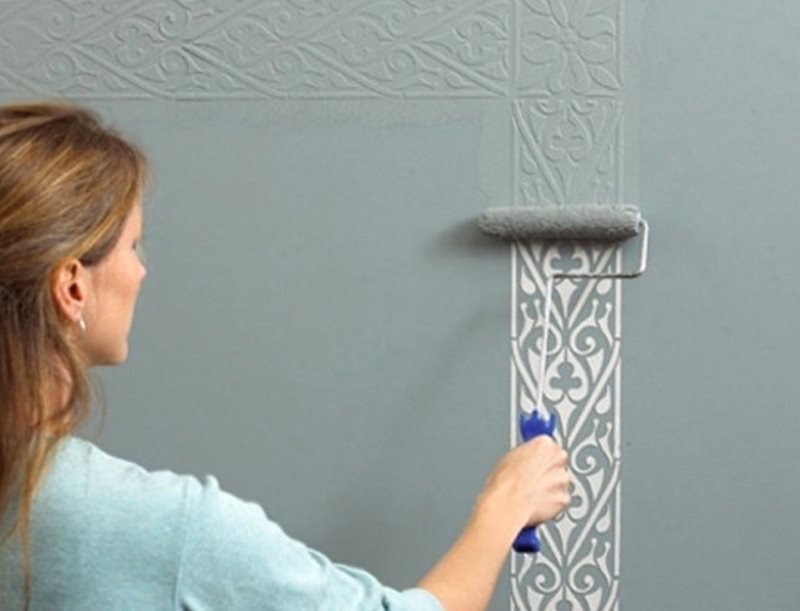
The technology is very simple - first the wall is covered with a base layer of paint, and then the desired decorative pattern is applied through the stencil
You can use store or homemade stencils made of plastic or linoleum.
- The use of paints with embossed texture of the material.

On relief paint, you can use a hard brush to create any texture
Beautiful, durable, resistant to moisture and mechanical stress, material. An additional advantage of using this type of dye is - surface leveling, with its help. The disadvantage is a significantly higher cost. It is applied with special brushes or a paint roller, allowing you to create original, effective patterns and drawings.
- Other original ways.
What colors are suitable for finishing a bathroom
Moisture resistance, vapor impermeability, resistance to fungal diseases and mold, life safety, compliance with the style of the interior - these are the main conditions that must be met when deciding: how to paint the walls in the bathroom instead of tiles.
Water emulsion dyes based on micropolymer compounds diluted with water are most widely used. They are characterized by low cost, durability, resistance to moisture and temperature.
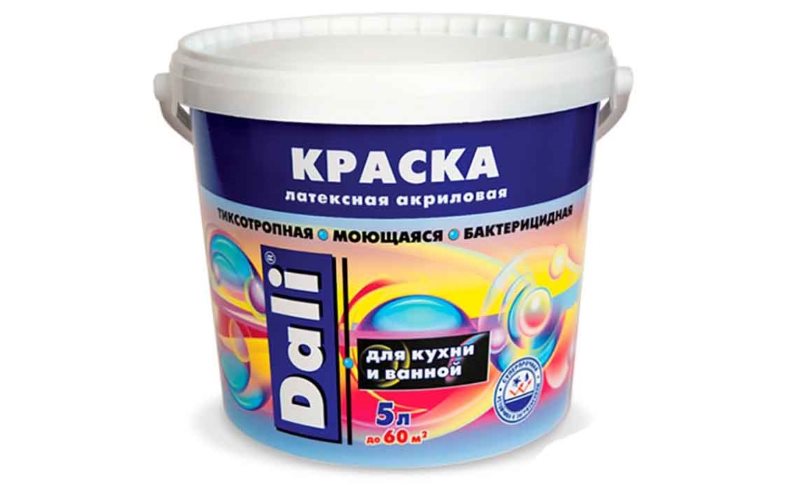
Among the “emulsions” the most common are latex acrylic paints, which have good resistance to water
Actually used water-based paints can be divided into several types:
- silicate;
- acrylic;
- silicone;
- chlorinated rubber;
- alkyd;
- oil.

Silicone mixtures are at the forefront of the ranking of the most expensive paints. They belong to the type of vapor-permeable compositions, therefore, they are almost ideal for “wet” walls
Not all of these species are recommended. Most preferred is the use of a bath emulsion of acrylic and silicone paints, when evaporated, forming on the surface a strong, moisture resistant and bactericidal protective film. Dry quickly, do not have a strong smell. They contain no toxic materials.

Any paint must be thoroughly mixed before use.
Choice of color and gloss
The main factors when choosing a matte or glossy shine are: the size of the room and the design of the environment, the possibility of its harmonious combination with style.
Matte coating
Matte gloss is most often used when painting walls in spacious rooms. It is less bright, but more versatile. Smoothes and blurs the outlines of the bathroom, makes the room more comfortable and contributes to its visual reduction. Matte walls blend well with classic interior styles, pastel colors and flowing lines.

Frosted French Provence Style Bathroom Walls
Coating the walls with a matte sheen allows you to hide irregularities and various surface defects.
Glossy surface
It looks more impressive, but even small wall irregularities, spots and stains are especially noticeable on the gloss. A room with a glossy shine requires a lot more effort to maintain it in good condition. Perfectly in harmony with such interior styles as: modern, minimalism, expressionist movements. The use of glossy paints in rooms with large mirror surfaces is appropriate.

The gloss on the walls will correct the imperfections of the room and make the bathroom space visually larger
Glossy paints are less susceptible to mechanical stress than matte paints.
Color spectrum
When deciding what and how to paint the walls in the bathroom, the choice of color is extremely important, since its effect on the psychosomatic state of a person is undeniable.
In the design of the bathtub, the colors most associated with the sea and sea wave are the most common: various shades of blue and green. This color helps to appease and has a calming, relaxing effect.

The pleasant turquoise color of the walls will remind you of vacation and relaxation at sea

Green coloring of the walls will bring freshness and summer mood to the interior
If the room is small, the designers recommend using colors in the light spectrum, so they push apart its visual perception. But you should not use exclusively white colors - this can lead to associations that are not entirely pleasant. White color - it is necessary to dilute with warmer and gentle shades or combine with bright decor elements.
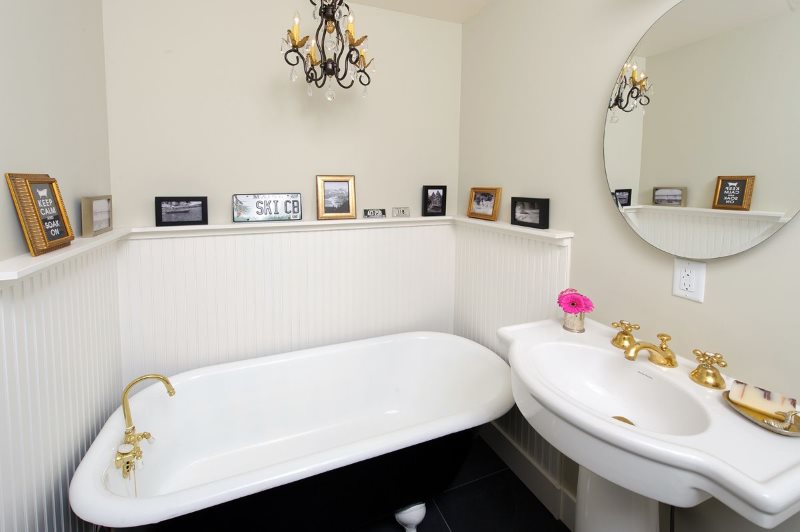
White - a universal color for interior decoration of a small bathroom

The red and white combination will appeal to fans of a bright and rich interior
The interior of spacious bathrooms often use contrasting colors. This technique is used to give greater emphasis to the individual elements of the room, to highlight and delimit zonal boundaries. The shower cubicle looks spectacular in aggressive colors against the background of a wall painted in calm, pastel colors.

Different colors can be used for zoning the space or underlining individual functional areas
Depending on the style, it is permissible to use dark colors, up to black, but at the same time, it is necessary to strictly maintain proportions.

In a fairly spacious bathroom, gray walls look good, against the background of which white plumbing stands out
Paints that are not recommended for painting in the bathroom
- Do not use emulsions containing PVA in rooms with high humidity! When interacting with water, this material becomes unsafe for the body.
- It is not recommended to finish the bathroom with oil paints. They have a persistent, unpleasant odor that does not weather for a long time. Dry for a long time, very susceptible to cracking.
- Alkyd enamels are also not recommended. Despite the visual appeal, alkyd enamels have a specific, stable odor.

The bathroom belongs to those rooms for the decoration of which you should not save
Video: real bathroom with painted walls
